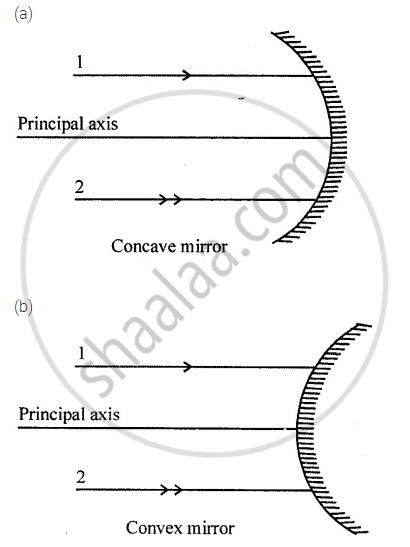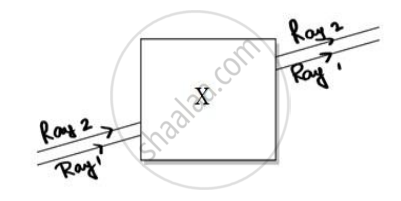Advertisements
Advertisements
प्रश्न
| Column I | Column II | Column III | |
| 1 | Dispersion | Long-sightedness | Twinkling of stars |
| 2 | Refraction | Splitting of white light into component colours | Convex lens |
| 3 | Hypermetropia | Change in the direction of the ray of light due to change in medium | Spectrum of seven colours |
उत्तर
| Column I | Column II | Column III | |
| 1 | Dispersion | Splitting of white light into component colours | Spectrum of seven colours |
| 2 | Refraction | Change in the direction of the ray of light due to change in medium | Twinkling of stars |
| 3 | Hypermetropia | Long-sightedness | Convex lens |
APPEARS IN
संबंधित प्रश्न
If an object is placed at a distance of 10 cm in from of a plane mirror, how far would it be from its image?
A ray of light strikes a plane mirror such that its angle of incidence is 30°. What angle does the reflected ray make with the mirror surface?
Which type of reflection of light leads to the formation of images?
What is the difference between regular reflection of light and diffuse reflection of light?
The image in a plane mirror is virtual and laterally inverted. What does this statement mean?
Write all the capital letters of the alphabet which look the same in a plane mirror.
The angle of reflection is equal to the angle of incidence:
(a) always
(b) sometimes
(c) under special conditions
(d) never
The image of an object formed by a plane mirror is:
(a) virtual
(b) real
(c) diminished
(d) upside-down
An object is placed 20 cm in front of a plane mirror. The mirror is moved 2 cm towards the object. The distance between the positions of the positions of the original and final images seen in the mirror is ______.
Explain how to read the following message which was found on some blotting paper:
A ray of light goes from water into air. Will it bend towards the normal or away from the normal?
As light rays pass from water into glass, are they refracted towards the normal or away from the normal?
Show the lateral displacement of the ray on the diagram.
How does the light have to enter the glass:
for no refraction to happen?
The depth of a pond when seen from above appears to be less.
Air is optically .......... than glass.
Match the Following
| Column A | Column B |
| (a) white Light | (1) Convex mirror |
| (b) Refraction | (2) Concave mirror |
| (c) Virtual images | (3) refraction |
| (d) Real images | (4) spectrum |
| (e) Prism | (5) ray of light from glass to air |
The diagram (figure) given below shows two parallel rays 1 and 2 incident on (a) a concave mirror, (b) a convex mirror. Draw the reflected rays and mark the focus by the symbol F.

What is atmospheric reflection? Explain with the help of a labelled diagram that the position of a star as seen by us is not its true position.
The laws of reflection hold true for:
Due to _______ pencil looks bent in water, in the given experiment.

The incident rays and refracting rays are on opposite sides of the normal.
The speed of light varies in different media.
Write scientific reason.
A pencil appears to be broken near the surface of water.
Explain the working of a periscope.
Numerical problems.
The speed of light in water is 2.25 × 108 ms–1. If the speed of light in vacuum is 3 × 108 ms–1, calculate the refractive index of water.
The refractive index of a transparent medium is always greater than ______.
If a beam of red light and a beam of violet light are incident at the same angle on the inclined surface of a prism from air medium and produce angles of refraction r and v respectively, which of the following is correct?
Noor, a young student, was trying to demonstrate some properties of light in her Science project work. She kept ‘X’ inside the box (as shown in the figure) and with the help of a laser pointer made light rays pass through the holes on one side of the box. She had a small butter-paper screen to see the spots of light being cast as they emerged.

Her friend noted the following observations from this demonstration:
- Glass is optically rarer than air.
- Air and glass allow light to pass through them with the same velocity.
- Air is optically rarer than glass.
- Speed of light through a denser medium is faster than that of a rarer medium.
- The ratio: sin of angle of incidence in the first medium to the ratio of sin of angle of refraction in the second medium, gives the refractive index of the second material with respect to the first one.
Which one of the combinations of the above statements given below is correct.
A pencil when dipped in water in a glass tumbler appears to be bent at the interface of air and water. Will the pencil appear to be bent to the same extent, if instead of water we use liquids like, kerosene or turpentine. Support your answer with reason.
Which object use the reflection of light?
The phenomenon of light passing through the object is called ______.
How does the light travel?
A star appears twinkling into the sky because of the reflection of light by the atmosphere.
Assertion: The air bubble shines in water.
Reason: Air bubble shines due to the refraction of light.
Under what circumstances there won’t be any refraction of light when it enters from one medium to another?
In refraction of light through a glass slab, the directions of the incident ray and the refracted ray are ______.
A ray of light starting from diamond is incident on the interface separating diamond and water. Draw a labelled ray diagram to show. the refraction of light in this case.
